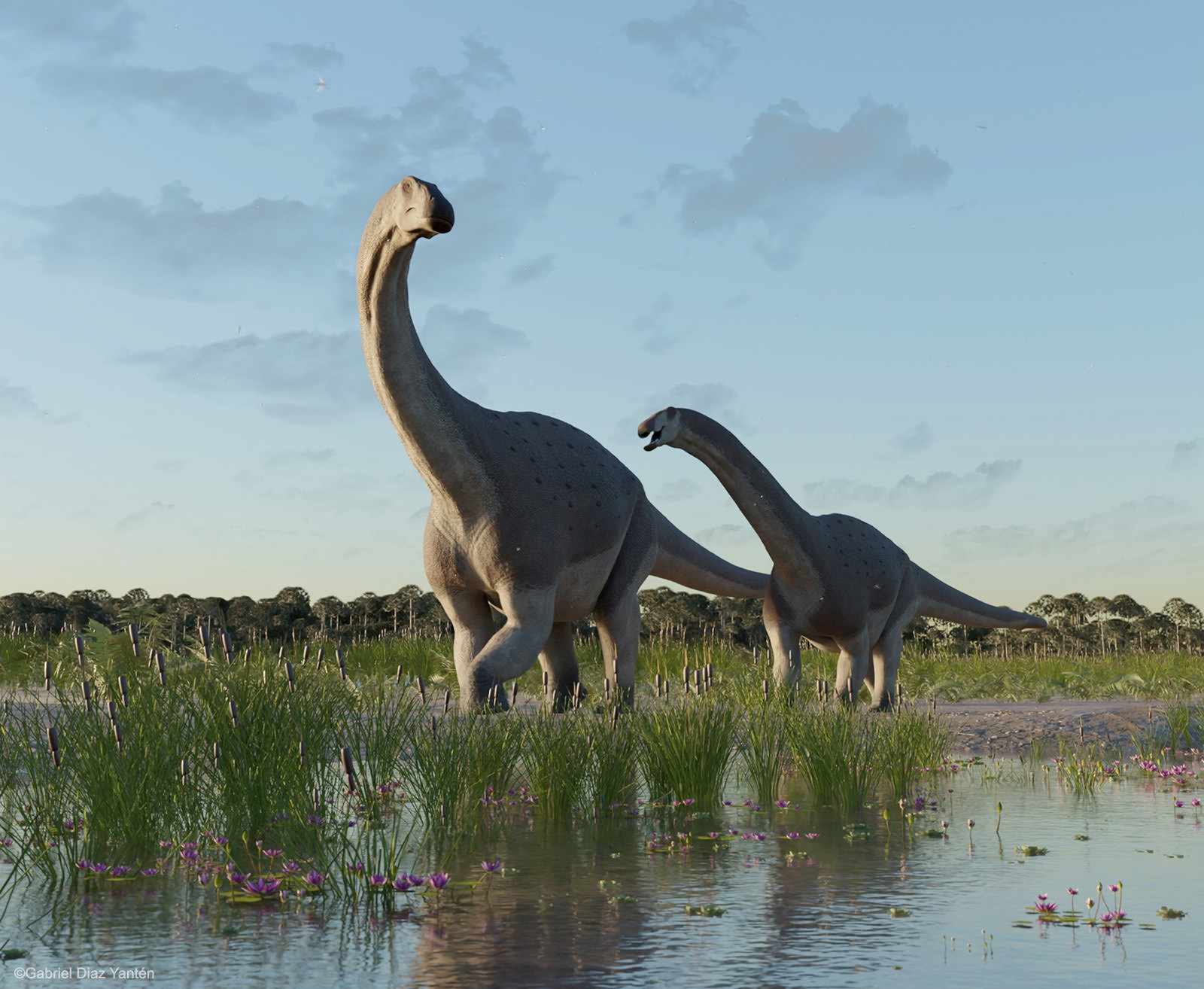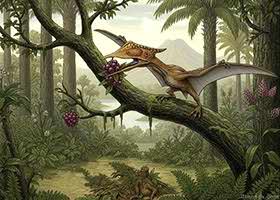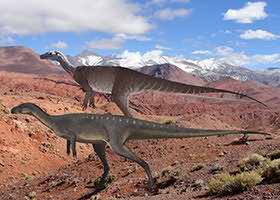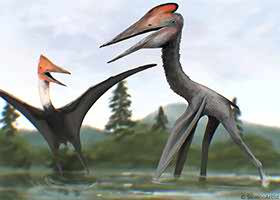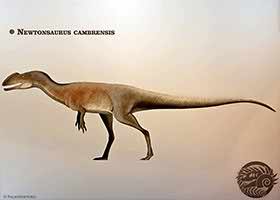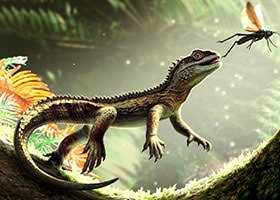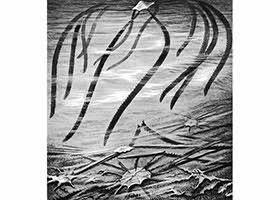
The discovery of Devonian tetrapod tracks is very rare, but they are of great significance for evolutionary history. They push back the appearance of tetrapods and their invasion of land even further in time. A critical parsing of these Devonian footprints identifies only four finds that we can definitively attribute to tetrapods. One from Poland, one from Australia, and two others from the British Isles.
- Zachełmie, Poland
- Genoa River, Australia
- Valentia Island, Ireland
- Tarbat Ness, Scotland

Valentia Island, Tarbat Ness, and Zachełmie are all located in the southern region of Laurussia. However, the Genoa River is a true outlier in the eastern part of the supercontinent Gondwana, halfway around the planet from the others.
Zachełmie, Poland
The earliest evidence of tetrapods in the fossil record is trace fossils (tracks and trackways) from the early Middle Devonian (approximately 391 million years old, early-middle Eifelian) in the abandoned Zachełmie quarry in Poland.

These are tracks of moving animals, varying in size and characteristics, as well as numerous isolated footprints and a densely trampled surface. There are also tracks left by limbs with digits. This indicates that these early tetrapods had well-developed limbs. The shape of the footprints varies depending on the size of the animal, its mode of locomotion, and the type of substrate.
The Zachełmie tracks represent the imprints of living organisms, unlike body fossils, which are more often subject to post-mortem transportation. Devonian tetrapod tracks provide direct evidence of an organism’s behavior and interactions with its environment.


The Zachełmie quarry tracks indicate much larger tetrapods than the Devonian trackways found in other localities and fossil tetrapod discoveries. The known fossil bodies of most Devonian tetrapods and their closest relatives among the “fishes” are much smaller animals. The Zachełmie quarry contains very large, “enigmatic” structures, measuring up to 50 centimeters long, which researchers have interpreted as the undertracks1 of tetrapods. However, no other known Paleozoic tetrapod tracks even approach this size.
Initial Reactions and Criticisms
The publication of the Zachełmie tracks2 sparked a series of skeptical responses, directed both at this discovery and at Devonian tracks in general. These responses asserted that fish, in one way or another, could in fact make these tracks. However, none of these claims withstands careful scrutiny (Ahlberg).
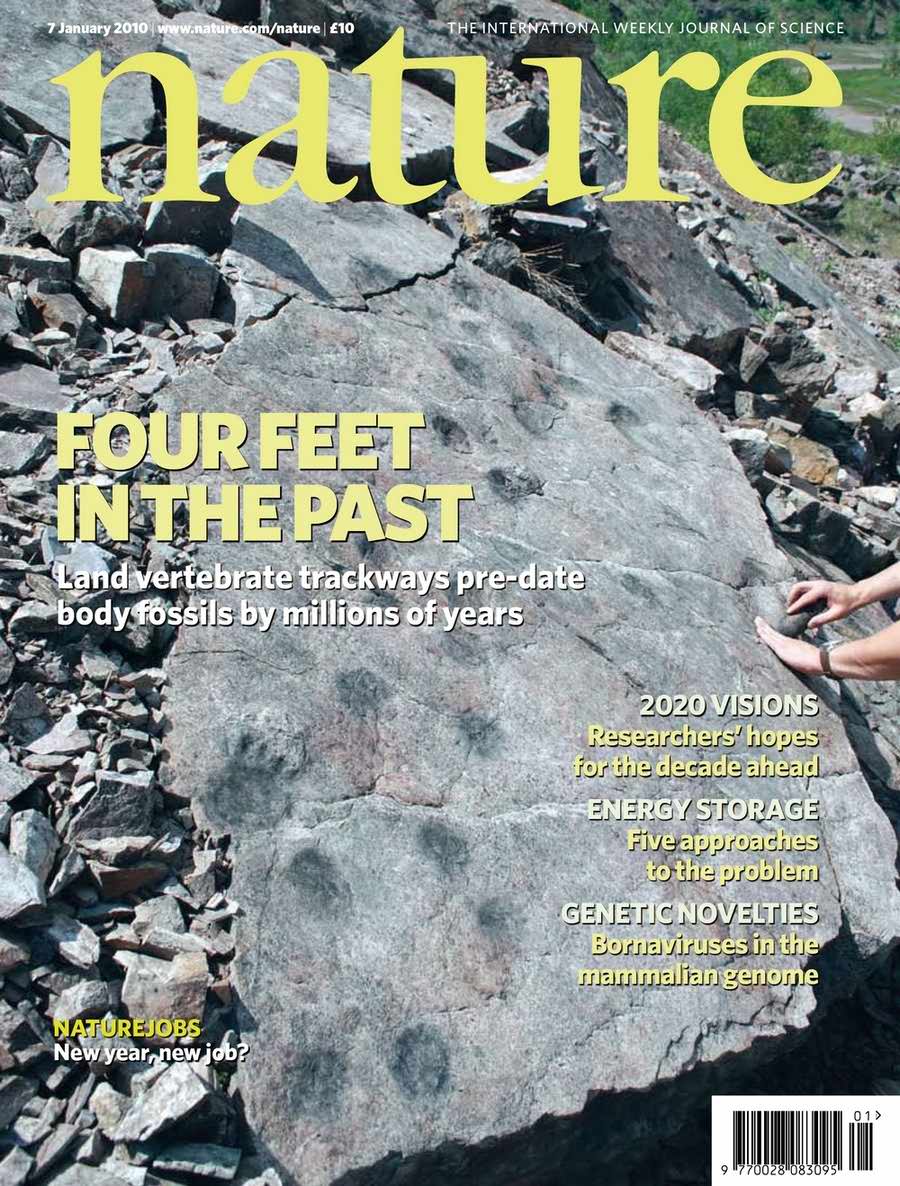
The trackways reflect the movement of tetrapods and their typical diagonal gait. But a significant portion of the Zachełmie tracks demonstrates a parallel, symmetrical gait, “ladder tracks” in Clack’s terminology (2010). Such “tracks” do not show any evidence of differentiation between the front and hind limbs, which would reflect skeletal morphology.3
Lucas (2015) argued that the Zachełmie tracks could have formed as a result of a combination of different types of fish activity, including feeding traces and the deposition of coprolites. However, the mechanisms proposed by Lucas cannot explain the deep and well-defined digit impressions, as well as the obvious trace ways.
Neil Shubin argued that Tiktaalik could have left very similar tracks. But, according to Shubin, a walking fish could have left some of the Zachełmie tracks, which lacked digits.
Widespread Acceptance of Zachełmie Tracks as the Oldest
Despite some initial debates and alternative hypotheses, the recognition of the structures from the Zachełmie quarry as the oldest tracks, and therefore the oldest record of tetrapods, has become widespread among authoritative researchers of early tetrapod evolution. For example, Janvier and Clement, 2010; Clack, 2012; Steyer, 2012; Ahlberg, 2018; Stanley & Luczaj, 2014.
Clack (2012) wrote: “It’s going to change all our ideas about why tetrapods emerged from the water, as well as when and where. We may well have to rethink the whole question of timing, sequence, and circumstances of the origin of tetrapods.”
Geologic Setting of the area of the discovery

The Zachełmie quarry is located in the northwestern part of the Holy Cross Mountains (Góry Świętokrzyskie), northern Lysogory region, in south-central Poland. These mountains formed during the Caledonian orogeny of the Silurian. In the Devonian, the region was located in a belt of marginal basins on the southern shore of the supercontinent Laurussia (Old Red Continent).
In the abandoned Zachełmie Quarry, the lower part of the Kowala Formation and the upper part of the Wojciechowice Formation are exposed. Conodonts4 from the costatus Zone indicate that the trace fossil-bearing layer in the Wojciechowice Formation corresponds to the very lowest Eifelian stage.

The Zachełmie quarry tracks lie within a layer of thinly bedded dolomite-micrites measuring between 3.2 and 3.8 meters thick.
Paleoecological environment of the site
Previously, it was believed that the site was located in a shallow marine (tidal or lagoon) sedimentary environment. A new interpretation proposes that the trace-bearing layer formed in terrestrial conditions along a coastal plain.
The sedimentary environment was located beyond the reach of ordinary spring tides, on the marine edge of a broad, flat coastal plain. This indicates a more terrestrial setting. Within this landscape, a succession of ephemeral (seasonal or temporary) muddy, shallow lakes developed. Their biota was limited and non-marine. One of these lakes seems to have become a brackish lagoon.
While the sea was nearby, these lakes were relatively isolated, with limited marine influence. Small streams carrying fine-grained clay minerals probably supplied water to the lakes. The sediments probably accumulated in a low-energy setting. But there is no evidence of a large river system.5
Limited Fauna and Climate
The water temperature was apparently high, around 30 °C. Cyclic changes in local climate or water supply periodically led to the drying up of the lakes and their replacement by plant soils.
The aquatic ecosystem was relatively simple, with a limited variety of life forms. The lakes contained a poor invertebrate fauna, but there is virtually no evidence of the presence of fish, except for one swimming trace of Undichna and a single fish scale. Low vegetation grew at the water’s edge, as evidenced by soil horizons with small rootlets.


The section contains several horizons with vertical root traces. These indicate a periodically stable plant cover, probably perennial vegetation. Carbonate deposits and paleosols are present, showing desiccation cracks and raindrop impressions, indicating a shallow-water environment. This indicates a dynamic environment with periods of drying, suggesting a seasonal or semi-arid climate.
Non-tetrapod Trace Fossils

The most common non-tetrapod trace fossils from these layers are large horizontal-vertical burrows of the Beaconites type6. Such burrows are plentiful on the upper surfaces of thick dolomite-micrite layers, particularly at certain paleosol levels. Most likely, large semiaquatic or terrestrial animals (e.g., worm-like organisms, arthropods, or vertebrates) made these burrows.
Dating of Devonian tetrapod tracks finds
These well-preserved and reliably dated Devonian tetrapod tracks are approximately 14 million years older than the earliest finds of tetrapod body fossils and 10 million years older than the fossils of the oldest elpistostegids (such as Tiktaalik from the Frasnian). They are approximately 5–6 million years older than the tracks from Valentia Island in Ireland. Thus, the Zachełmie tracks seem to demonstrate that tetrapods evolved and were walking on land already in the Middle Devonian.
Dating Methodology and Age Range

The upper age limit of the tracks was dated based on a complex of conodonts located 15 m above the uppermost trace-bearing layer. This analysis provides a maximum age for the tracks. Researchers estimate the age of the Zachełmie tracks to be between 390 and 391 million years, placing them in the early-middle Eifelian epoch. This new estimate is 4–5 million years younger than previous calculations.7
The tracks in Zachełmie indicate that very large stem-tetrapods8, exceeding 2 meters in length, lived along the southern coast of Laurussia as early as the early Eifelian. This leads us to postulate much longer “ghost lineages”9 for tetrapods and elpistostegids than is suggested by the fossil record.
General characteristics of Zachełmie tracks and trackways

The fossil trackway includes numerous tracks of varying size and characteristics, as well as a large number of isolated impressions. This suggests a variety of animals that left these imprints. The tracks originate from three stratigraphic horizons and, in total, include nine “trackways” and 220 “tracks”.


The preservation of the track assemblage and the appearance of the impressions vary greatly depending on the size of the animal, the condition of the sediment, and the nature of the movement. Some clearer tracks preserve fine morphology, such as toes, while others are more diffuse and only preserve an outline. Toe prints may be present or absent, likely depending on the consistency of the sediment. Very clear and detailed impressions occur. The varying quality of preservation offers a glimpse into the different conditions under which these tracks were formed.
Aquatic Behavior of Early Tetrapods
These early tetrapods primarily created these tracks, mainly in shallow water. Animals probably created the Zachełmie tracks while swimming or wading along the lagoon bottom, either submerged or partially submerged. If these creatures were partially swimming, it would explain why there’s no central trail left by their bodies and tails dragging on the sediment. The early tetrapods that left these tracks were not fully terrestrial.
The presence of digit prints, along with the absence of body and tail drag marks in combination with unequivocally tetrapod-like tracks, confidently point to early tetrapods as the trackmakers. This rejects alternative interpretations, such as tracks made by elpistostegids or resting fish.
Devonian tetrapod Tracks Preservation and Distribution
Isolated tracks and trackways were found both in situ and on loose slabs from the talus at the base of the section. Two of the three track-bearing horizons (horizons A and B) are located in the eastern part of the quarry, and one in the western part (horizon C). These Devonian tetrapod tracks are located in different parts of the quarry and, accordingly, have different degrees of preservation. Toe prints vary depending on the substrate, and track sizes vary depending on the size of the animal and the type of locomotion.
Track Size and Animal Size

There are footprints of various sizes. Some animals had a length of 40–50 cm. Others had a track width of 15 cm. The stride10 is very wide relative to body length (much greater than in Tiktaalik or any other fish). The largest tracks (up to 26 cm wide) are about twice the linear dimensions of the best-preserved Ichthyostega foot skeleton, suggesting that the early tetrapods responsible for these tracks could have been up to 2.5 meters long. However, researchers haven’t discovered any fossils of early tetrapods in this area.
A 2012 study of the biomechanics showed that the trackmakers of Zachełmie were even more advanced than Ichthyostega in terms of adaptation to a quadrupedal lifestyle.
Tetrapod trackways

Trackway catalog numbers from Zachełmie:
Muz. PGI 1728.II.7-9, 11, 14: trackways.
Muz. PGI 1728.II.10: surface with numerous tracks or undertracks, probably partially preserved trackway.
Muz. PGI 1728.II.12, 13: ?manus and pes sets.
Muz. PGI 1728.II.15: manus and pes prints, trackway.
Muz. PGI 1728.II.16: manus and pes prints, trackway.
Muz. PGI 1728.II.17a, b: ?trackway.

Sample track (Muz. PGI 1728.II.7, Geological Museum of the Polish Geological Institute) with numerous, partially overlapping imprints. The assumed direction of locomotion is from bottom to top.
Trackway Muz. PGI 1728.II.7 has numerous, partially overlapping footprints.

Trackway Muz. PGI 1728.II.16 shows distinct alternating manus (hand) and pes (foot) impressions of slightly varying sizes, arranged in a diagonal sequence. The animal moved in a straight line and left no body trace. The footprints are rounded, without discernible finger impressions or displacement rims11.
Scientists interpret this trackway as a series of 4–5 steps, in which smaller “manus” impressions precede larger “pes” impressions. The trackmaker must have had long limbs and a wide body.
The stride length, intervals between footprints, and lack of body drag marks indicate that Muz. PGI 1728.II.16 is the track of a tetrapod. In any case, the absence of a sacrum would not allow a fish-like animal to raise its tail above the substrate.

Assuming standard proportions for early tetrapods, the total length of this trackmaker was probably around 40–50 cm.
On the same slab, there is one large footprint with traces of toes (Muz. PGI 1728.II.1). The presence of this footprint provides further evidence to support the tetrapod interpretation.

Trackway Muz. PGI 1728.II.15 is a track left by a slightly smaller animal. The pattern of its steps somewhat resembles a ladder, suggesting that for several steps the animal moved its limbs in parallel rather than alternately. The steps are short, and there are no noticeable differences between the manus and pes impressions.
If this is a true track preserving the actual sediment surface with foot impressions, then the animal moved using only one pair of limbs. These tracks could be from a tetrapod partially submerged in water, pushing off the ground with only one pair of legs. In summary, this trackway presents a puzzle for paleontologists.
Individual limb impressions
Catalog numbers of individual limb impressions:
Muz. PGI 1728.II.1.
Muz. PGI 1728.II.2a, b.
Muz. PGI 1728.II.3.
Muz. PGI 1728.II.5: Left pes.
Muz. PGI 1728.II.6.



The best Zachełmie track with various overlays. The origins of tetrapods go further back than previously thought. The Early Devonian must have provided sufficient niches for such rapid evolution. And even they had more than five toes.
In addition to tracks and trackways associated with tetrapod walking, researchers have also found individual large footprints that likely belong to swimming tetrapods striking their feet against the substrate. As in other tracks from younger Middle or Late Devonian strata, documented hand and foot prints are present here. This, together with the stride length and step length of the tracks, excludes early tetrapod ancestors such as elpistostegids as the trackmakers.

In the quarry’s scree, researchers discovered several other large footprints. They provide an idea of the foot morphology of the largest Zachełmie tetrapods. In most cases, the width of the foot, measured at the junction of the sole and toe impressions, is, on average, about 15 cm. This is more than twice the linear dimensions of the best-preserved foot of Ichthyostega. The length of the animal could be about 2.5 m.

Muz. PGI 1728.II.1. Located on the same slab as the trackway Muz. PGI 1728.II.16. It has a medium size and a low, forward-shifted edge. The outlines are clear. It shows three large, short, triangular toe impressions. The foremost one deviates somewhat from the other two. Behind them, a thin toe is visible. In front of the triangular toes, another thin toe is visible, deviated forward. Left pes. This is clearly an underwater footprint, where a swimming tetrapod used one limb to push against the substrate.

Muz. PGI 1728.II.2. It has a very small rim along the front edge of only one of the toe impressions. The toe impressions are short and triangular. The outlines are clear. They show three large, triangular toe impressions, the foremost of which deviates somewhat from the other two. In front of the triangular toes, there are two identical toes located side by side. The thin toe that is visible on Muz. PGI 1728.II.1 did not leave an impression here. Left pes.

Muz. PGI 1728.II.3. Demonstrates long, curved toe impressions and a large displacement rim. The large displacement of the edge of the impression suggests that the foot slipped during the formation of the track. The size of the displacement rim might also provide clues about the animal’s weight. Left pes.
Muz. PGI 1728.II.5. Short, triangular toe impressions. The outlines are clear. This indicates that the sediment was firm enough to preserve the details of the footprint. This is the largest impression, with a width of 26 cm. Left pes.
Overall Analysis of the Footprints

The individual footprints from Zachełmie show short, triangular toes without claws, webbing, or separate phalangeal pads. At the same time, such pads may be faintly discernible on the thin toes. However, there is a small, distinct pad at the tip of each triangular toe.
The shape closely resembles Ichthyostega’s hind foot, especially if we reconstruct Ichthyostega with an anatomically correct sole that reaches the bases of the first phalanges. When the foot likely entered the sediment at an angle, the toe impressions appeared as short, rounded dimples on the outer edge. This pattern matches the Late Devonian impressions found at the Genoa River in Australia.
Comparing Zachełmie Tracks to Other Devonian Tetrapod Tracks

Some Zachełmie tracks have long sole impressions that appear to represent not only the sole of the foot itself, but also the flexor surface of the shank. This is consistent with fossil evidence that early tetrapods, such as Ichthyostega and Acanthostega, had flat ankles with limited flexibility, similar to their aquatic ancestors (Coates 1996). These tetrapods had short and broad feet. Comparison of Muz. PGI 1728.II.1 with their skeletons confirms that the impression includes the ventral surface of the leg and knee and suggests a nearly flat ankle.

On the left is a generic Devonian tetrapod based on Ichthyostega and Acanthostega fitted to the trackway. On the right, Tiktaalik (with a tail reconstructed from Panderichthys) is drawn to the same shoulder-hip length. The positions of pectoral fins show an approximate maximum “stride length”.
The best-preserved Zachełmie tracks are very similar to the foot morphology of Acanthostega and, especially, Ichthyostega. For the latter two genera, it is possible to reconstruct an approximate morphology of the tracks, although with less accuracy for Acanthostega since the foot skeleton is only partially reconstructed.
Trackway Muz. PGI 1728.II.16 from Zachełmie is very similar to other described Devonian tetrapod tracks. Tracks from Valentia Island (Ireland) and Tarbat Ness (Scotland), as well as one of the Genoa River tracks (Australia), demonstrate similar diagonal patterns of forelimb and hindlimb impressions without any signs of body dragging. All these Devonian tetrapod tracks are clearly younger than those from Zachełmie.
Doubtful traces
More problematic is the Glenisla trackway from Australia, which, judging by all appearances, originated no later than the Late Silurian. The known fossil record of this period includes stem-sarcopterygians, but not lobe-finned tetrapodomorphs or tetrapods. The trackway has a ladder-like pattern, which some use as evidence that it’s not from a tetrapod. However, this pattern is also common in other Zachełmie tracks.
Sparse Body-Fossil Record in Zachełmie Quarry

In Zachełmie Quarry, there is an almost complete absence of body fossils; this environment was clearly not conducive to the preservation of skeletons. The few fossils found in the Lower Complex Wojciechowice Formation are very poor and include only: conodonts, foraminifera, ostracods, and small bivalves, confined to narrow intervals located below and above the trace fossil horizon. Spores and acritarchs are present; structures formed by plant roots; macroscopic fragments of vascular plants; and a few isolated fish remains.
Fossils of marine organisms (e.g., conodonts, ostracods, foraminifera) in the interval of the Lower Complex are generally poorly preserved and clearly destroyed because of reworking. It is possible that during storms, there was an episodic local transport and reworking of small (conodont remains) or shelf fauna from a neighboring marginal marine environment into the muddy depositional environment of the Lower Complex.
In contrast, the Upper Complex contains numerous layers relatively rich in marine fossils, such as echinoderms (crinoids), bryozoans, scolecodonts, fish, and conodonts, but it lacks horizons with desiccation cracks or paleosols.
The lifestyle of tetrapods in Zachełmie

What were the tetrapods doing in the Lower Complex environment? All known elpistostegids and Devonian tetrapods are predators with somewhat crocodile-like heads and teeth suitable for capturing relatively large prey, so it is probably safe to assume that the Zachełmie trackmaker conformed to this general morphotype.
The tracks and trackways preserved in Zachełmie formed underwater (subaqually). The small, ephemeral lakes of the Lower Complex were a very poor aquatic ecosystem. It seems unlikely that this impoverished fauna could have served as a food source sufficient to sustain two-meter-long predatory tetrapods for any extended period. It is more likely that they fed in other places, possibly on land.
From time to time, they used the lakes for other purposes, such as rehydration or reproduction; the latter is an intriguing possibility in view of the apparent absence of other predators in the lake environment. This made them a safer environment for reproduction.

Devonian tetrapod tracks confirm their early terrestrial adaptation
Data from the Lower Complex Wojciechowice Formation provides indirect evidence of early terrestrial adaptation in tetrapods. The tracks formed by paired appendages with digits and discrete sole pads, markedly different from the fins of lobe-finned fish.
The ecological setting suggests that the trackmaker used its limbs both on land and in water. Thus, unlike littoral, forested, or lagoonal scenarios, the proposed model of tetrapod evolution in ephemeral lakes relies on the use of limbs not only in shallow water environments but also during movement outside the aquatic habitat.
The evidence suggests that these tetrapods were tolerant of marine conditions. This is characteristic of both Late Devonian tetrapods, based on their wide distribution in Laurasia and Gondwana, and their habitation in deposits subject to tidal influences.
- In this case, the term “undertracks” does not refer to the original imprint on the ground that the animal moved across, but rather to its secondary impressions on the underlying layer of soil. Consequently, these tracks are less distinct, less precise, and often appear more distorted. ↩︎
- Niedźwiedzki, G., Szrek, P., Narkiewicz, K., Narkiewicz, M. & Ahlberg, P.E. 2010: Tetrapod trackways from the early Middle Devonian period of Poland. ↩︎
- Spencer G. Lucas, 2015. Thinopus and a Critical Review of Devonian Tetrapod Footprints. ↩︎
- Scientists often use microscopic fossils called conodonts to date sedimentary rocks. ↩︎
- Qvarnström et al., 2018. Non-marine palaeoenvironment associated to the earliest tetrapod tracks. ↩︎
- Beaconites: Larger animals likely made these large, complex burrows. ↩︎
- Katarzyna Narkiewicz and Marek Narkiewicz, 2015. The age of the oldest tetrapod tracks from Zachełmie, Poland. ↩︎
- Stem-tetrapods are a group of organisms that are part of the evolutionary lineage leading to tetrapods (four-limbed vertebrates) but do not belong to the crown group of modern tetrapods. They represent transitional forms between fish and the first true tetrapods. ↩︎
- Ghost lineage: This is a hypothetical evolutionary lineage for which there is no direct fossil evidence, but whose existence is inferred from the fossil record of related organisms. ↩︎
- Stride length is the distance measured from the point of initial contact of one foot to the point of initial contact of the same foot on the next step. ↩︎
- Displacement rims: raised and deformed edges around a footprint. When a tetrapod steps onto a soft surface and then lifts its foot, the displaced material can create a rim or elevated edge around the footprint, capturing the outline of the foot and the movement dynamics. ↩︎




